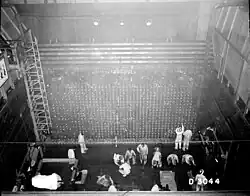Portal:Nuclear technology/Articles/7
The Hanford Site is a decommissioned nuclear production complex operated by the United States federal government on the Columbia River in Benton County in the U.S. state of Washington. It has also been known as Site W and the Hanford Nuclear Reservation. Established in 1943 as part of the Manhattan Project, the site was home to the Hanford Engineer Works and B Reactor, the first full-scale plutonium production reactor in the world. Plutonium manufactured at the site was used in the first atomic bomb, which was tested in the Trinity nuclear test, and in the Fat Man bomb used in the bombing of Nagasaki.

During the Cold War, the project expanded to include nine nuclear reactors and five large plutonium processing complexes, which produced plutonium for most of the more than sixty thousand weapons built for the U.S. nuclear arsenal. Nuclear technology developed rapidly during this period, and Hanford scientists produced major technological achievements. The town of Richland, established by the Manhattan Project, became self-governing in 1958, and residents were able to purchase their properties. After sufficient plutonium had been produced, the production reactors were shut down between 1964 and 1971.
Many early safety procedures and waste disposal practices were inadequate, resulting in the release of significant amounts of radioactive materials into the air and the Columbia River, resulting in higher rates of cancer in the surrounding area. The Hanford Site became the focus of the nation's largest environmental cleanup. A citizen-led Hanford Advisory Board provides recommendations from community stakeholders, including local and state governments, regional environmental organizations, business interests, and Native American tribes. Cleanup activity was still ongoing in 2023, with over 10,000 workers employed on cleanup activities.
Hanford hosts a commercial nuclear power plant, the Columbia Generating Station, and various centers for scientific research and development, such as the Pacific Northwest National Laboratory, the Fast Flux Test Facility and the LIGO Hanford Observatory. In 2015 it was designated as part of the Manhattan Project National Historical Park. Tourists can visit the site and B Reactor. (Full article...)